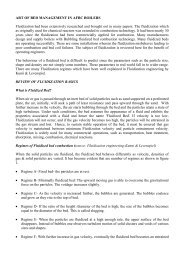You also want an ePaper? Increase the reach of your titles
YUMPU automatically turns print PDFs into web optimized ePapers that Google loves.
SIR CHANDRASEKHARA VENKATA RAMAN, FRS<br />
(7 NOVEMBER 1888 – 21 NOVEMBER 1970)<br />
He was an Indian physicist whose work was <strong>in</strong>fluential <strong>in</strong> the<br />
growth of science <strong>in</strong> the world. He was the recipient of the Nobel<br />
Prize for Physics <strong>in</strong> 1930 for the discovery th<strong>at</strong> when light traverses<br />
a transparent m<strong>at</strong>erial, some of the light th<strong>at</strong> is deflected changes <strong>in</strong><br />
wavelength. This phenomenon is now called Raman sc<strong>at</strong>ter<strong>in</strong>g and<br />
is the result of the Raman effect.<br />
On February 28, 1928, through his experiments on the sc<strong>at</strong>ter<strong>in</strong>g of<br />
light, he discovered the Raman effect. It was <strong>in</strong>stantly clear th<strong>at</strong> this<br />
discovery was an important one. It gave further proof of the<br />
quantum n<strong>at</strong>ure of light. Raman spectroscopy came to be based on<br />
this phenomenon, and Ernest Rutherford referred to it <strong>in</strong> his<br />
presidential address to the Royal Society <strong>in</strong> 1929. Raman was<br />
president of the 16th session of the Indian Science Congress <strong>in</strong><br />
1929. He was conferred a knighthood, and medals and honorary doctor<strong>at</strong>es by various universities.<br />
Raman was confident of w<strong>in</strong>n<strong>in</strong>g the Nobel Prize <strong>in</strong> Physics as well, and was disappo<strong>in</strong>ted when the<br />
Nobel Prize went to Richardson <strong>in</strong> 1928 and to de Broglie <strong>in</strong> 1929. He was so confident of w<strong>in</strong>n<strong>in</strong>g<br />
the prize <strong>in</strong> 1930 th<strong>at</strong> he booked tickets <strong>in</strong> July, even though the awards were to be announced <strong>in</strong><br />
November, and would scan each day's newspaper for announcement of the prize, toss<strong>in</strong>g it away if it<br />
did not carry the news. He did eventually w<strong>in</strong> the 1930 Nobel Prize <strong>in</strong> Physics "for his work on the<br />
sc<strong>at</strong>ter<strong>in</strong>g of light and for the discovery of the effect named after him. He was the first Asian and first<br />
non-White to receive any Nobel Prize <strong>in</strong> the sciences. Before him Rab<strong>in</strong>dran<strong>at</strong>h Tagore (also Indian)<br />
had received the Nobel Prize for Liter<strong>at</strong>ure.<br />
C.V Raman & Bhagavantam, discovered the quantum photon sp<strong>in</strong> <strong>in</strong> 1932, which further confirmed<br />
the quantum n<strong>at</strong>ure of light.<br />
Raman also worked on the acoustics of musical <strong>in</strong>struments. He worked out the theory of transverse<br />
vibr<strong>at</strong>ion of bowed str<strong>in</strong>gs, on the basis of superposition velocities. He was also the first to<br />
<strong>in</strong>vestig<strong>at</strong>e the harmonic n<strong>at</strong>ure of the sound of the Indian drums such as the tabla and the<br />
mridangam.<br />
Raman and his student Nagendran<strong>at</strong>h, provided the correct theoretical explan<strong>at</strong>ion for the acoustooptic<br />
effect (light sc<strong>at</strong>ter<strong>in</strong>g by sound waves), <strong>in</strong> a series of articles result<strong>in</strong>g <strong>in</strong> the celebr<strong>at</strong>ed<br />
Raman-N<strong>at</strong>h theory. Modul<strong>at</strong>ors, and switch<strong>in</strong>g systems based on this effect have enabled optical<br />
communic<strong>at</strong>ion components based on laser systems. lo<br />
In 1934, Raman became the director of the Indian Institute of Science <strong>in</strong> Bangalore, where two years<br />
l<strong>at</strong>er he cont<strong>in</strong>ued as a professor of physics. Other <strong>in</strong>vestig<strong>at</strong>ions carried out by Raman were<br />
experimental and theoretical studies on the diffraction of light by acoustic waves of ultrasonic and<br />
hypersonic frequencies (published 1934-1942), and those on the effects produced by X-rays on<br />
<strong>in</strong>frared vibr<strong>at</strong>ions <strong>in</strong> crystals exposed to ord<strong>in</strong>ary light.


















